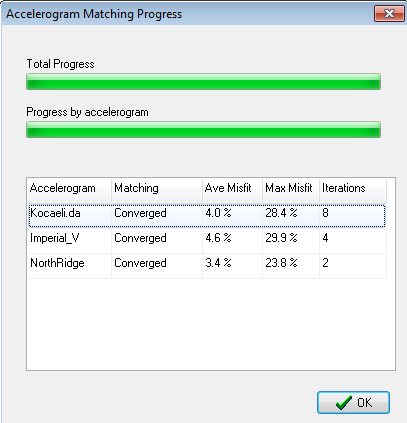Spectral matching
SeismoMatch main function is to adjust ground-motion records so that their spectral acceleration response matches a target response spectrum. The user can choose between 2 wavelets algorithms for spectral matching operation, which are available in Matching Parameters tab of the Program Settings menu. The first method has been described by Hancock et al. (2006). It requires base line correction to eliminate drift in the corresponding velocity and displacement time series, while numerical integration and additional wavelets are implemented for the convergence of the solution. Second algorithm has been developed by Al Atik & Abrahamson (2010). An improved tapered cosine adjustment function prevents drift in the modified velocity and displacement time series without base line correction. Dynamic padding of the beginning of the acceleration time series performed when the time of its peak response at a certain frequency (tj) is small compared to the duration of the record. Pseudo-acceleration response spectra are calculated by Newmark’s integration scheme.
After loading some accelerograms and defining the target spectral response (Steps 1 and 2, described in here), the user needs only to define the matching algorithm, adjust the matching period range, set the required tolerance and press Do Matching. These parameters can either be defined on the main pre-processing window of the program (see Step 3 section) or on the Matching parameters module of the Program Settings. Once the matching process is triggered, a pop-up window will be displayed showing the progress of each accelerogram as well as information on spectral misfit, iterations and tolerance.

Several information is displayed for each matched accelerogram in this window, such as the matching outcome (converged or not), average misfit, maximum misfit, and number of iterations that were used. If convergence was not achieved for a given record, the user can always increase the number of iterations or the number of waves applied (see below).
Spectrum Matching parameters
It is noted that with the exception of the 'Matching period range', the 'Scale factor' and the 'Mismatch Tolerance' (all of which are also readily available from the main program window - Step 3 section), the remaining of the parameters described below are really intended for expert users that may be very familiar with the algorithm and the corresponding scientific publications (they are accessible from the Settings).
Mismatch tolerance
This parameter specifies the tolerance for maximum mismatch which controls the convergence process.
Max iterations
If convergence is not achieved within the number of iterations specified here, the matching process is stopped (a relatively large default value of 30 is set - see Notes 1&2 below).
Scale Factor
Factor that can be used to scale the original time-history (e.g. 9.81, if the original accelerogram is defined in "g" and the target spectrum in m/s2).
Min Eigen Value
Minimum normalized eigen value used in singular value decomposition. A smaller value provides more rapid but less stable convergence (recommended value is 1.0e-4).
Max number of waves
Maximum number of waves for wavelet model. The smaller the value, the poorer the matching. Typically, a value higher than the default (10) has no significant effect on the results.
Number additional waves
Maximum number of "additional wavelet" iterations/sub-iterations used to prevent divergence by adding wavelets or reducing correction amplitude (recommended value is 20).
Off diagonal reduction
Reduction in the off diagonal elements provide better convergence, though a value smaller than 0.7 (default) may corrupt the velocity and displacement time series.
Group size
Further control on convergence can be achieved by splitting the design spectrum into a number of sub-groups. The recommended default value is 250.
Min and Max period
Lower and upper period bounds within which spectral matching is carried out.
a1, a2, f1, f2
These so-called alpha model parameters are recommended to feature the values 1.25, 0.25, 1.0 and 4.0, since other combinations may change the frequency dependency of the model and render it inconsistent with the reference time-history, thus resulting in large misfit.
Target PGA, Adjustment frequency, Damping and Cycles number
PGA correction parameters that may be left unchanged for typical applications.
Allow dynamic padding of the beginning of the acceleration time series
The user can specify whether or not to activate dynamic padding of the beginning of the acceleration time series.
Notes
- If a given record requires a very large number of iterations to achieve matching, then its original non-stationary characteristics are likely to be lost, which somehow defeats the purpose of the spectrum matching exercise itself - users should select an alternative record, in such cases.
- Records whose spectral matching process did not reach convergence within the maximum iterations (i.e. that may feature a spectrum with some parts that do not respect the specified tolerance or maximum misfit) may still be considered as useful by the user, in particular when the latter is interested in the computation of mean matched spectra.
- On the other hand, however, Jayaram et al. [2011] note that if a Uniform Hazard Spectrum (UHS), typical of design codes, is adopted as target spectrum, the matched records should feature spectra with no additional variance about the UHS, since the latter already accounts for variability in spectral accelerations at each period being considered (the UHS is obtained through a conservative combining of such spectral values).
- The spectrum matching period range (defined by the Min and Max period parameters) should, in principle, consider not only the fundamental vibration period of the structure that will be analysed through nonlinear dynamic analysis, but also the higher modes that might affect the structure's response as well as the effects of period elongation due to damage accumulation (and corresponding structure stiffness decrease).
- Setting an exaggeratedly large matching period range, however, may force the original non-stationary characteristics of the record to be lost (or prevent convergence of the matching process), hence care should be exercised in the definition of this input parameter.